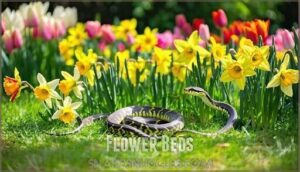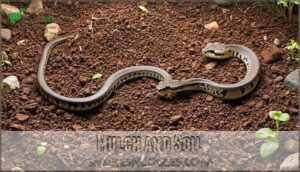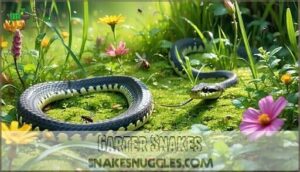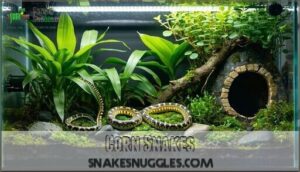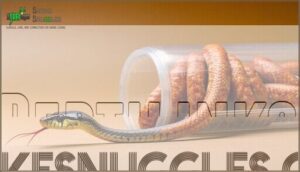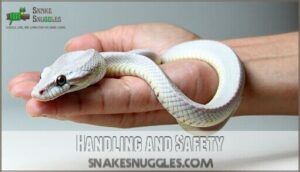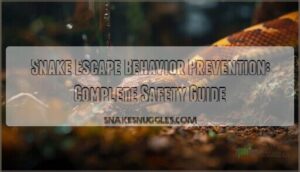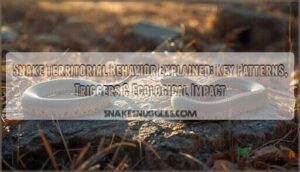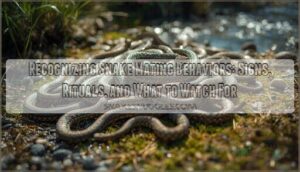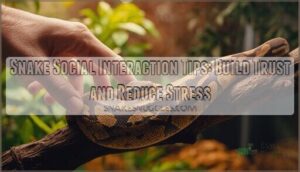This site is supported by our readers. We may earn a commission, at no cost to you, if you purchase through links.

**
You’ll find small snakes adapt well to captivity while displaying fascinating behaviors and stunning patterns. **Their manageable size means less intimidating handling sessions and lower maintenance costs.
**
The key lies in understanding each species’ specific habitat needs, from soil moisture to temperature requirements, ensuring your tiny serpent thrives in its new home.
Table Of Contents
- Key Takeaways
- Snake Identification
- Habitat and Behavior
- Diet and Nutrition
- Handling and Safety
- Conservation Efforts
- Frequently Asked Questions (FAQs)
- What are the different types of small pet snakes?
- What are the best small pet snakes?
- What is the smallest snake you can keep as a pet?
- How do small snakes reproduce?
- What are the common predators of small snakes?
- Can small snakes recognize their owners?
- How do weather changes affect small snakes?
- What are the signs of illness in small snakes?
- What size tank do small snakes need?
- How often do small snakes shed skin?
- Conclusion
Key Takeaways
- You’ll find small snakes like ringneck, smooth earth, and corn snakes stay between 12-24 inches, making them perfect for beginners who want manageable pets without overwhelming space requirements.
- You can easily handle most small snake species since they’re gentle and rarely bite, though you’ll need to properly identify species first to avoid dangerous venomous varieties like coral snakes.
- You’ll discover feeding is straightforward with appropriately-sized prey like pinkie mice or invertebrates, and species like garter snakes adapt well to captive feeding schedules.
- You’ll need a proper habitat setup with the correct substrate, temperature gradients of 75-85°F, and escape-proof enclosures that maintain proper humidity without becoming waterlogged.
Snake Identification
Identifying small pet snakes requires examining specific physical characteristics that distinguish different snake species. Scale patterns reveal vital information—ringneck snakes display smooth, glossy scales, while western hognose snakes show keeled textures. Color variations and markings analysis help discern species; ball pythons exhibit distinct banding patterns compared to solid-colored specimens.
Head morphology varies substantially—pointed heads indicate burrowing species, while triangular shapes suggest different feeding habits. Body shape also matters; some species maintain slender profiles throughout their lives, while others develop stockier builds. These identification features guarantee you’ll recognize your perfect companion.
Habitat and Behavior
You’ll find small snakes in three main environments where they hunt for prey and seek shelter. These species adapt their behavior to match specific habitat conditions, from loose garden soil to dense forest undergrowth.
Flower Beds
Your Garden Layout becomes a haven for small pet snakes like beginner snakes and nonvenomous pet snakes when you incorporate diverse Flower Choices and maintain quality Soil Quality. These small snake species thrive in flower beds because they’re hunting grounds for slugs and insects.
Your small pet snake candidates include earth snakes and garter snakes, which burrow through loose soil with ease. Smart Yard Design with varied plantings provides natural Pest Control as these serpents eliminate garden pests while remaining completely harmless to you.
Effective flower bed plants, such as those found in flower bed options, can augment the biodiversity of your garden.
Mulch and Soil
When creating the perfect captive environment for your small pet snake, understanding soil moisture and mulch types is essential for replicating natural conditions. Garden beds in your enclosure should maintain proper soil temperature and humidity levels to keep your snake comfortable.
Choose substrates like cypress mulch or aspen shavings that retain moisture without becoming soggy. Avoid cedar or pine mulches, which can irritate respiratory systems. Monitor temperature gradients carefully—your escape proof enclosure requirements include maintaining 75-85°F on the warm side.
Smart substrate choice prevents respiratory issues while maintaining proper humidity and temperature gradients for healthy snake keeping
Captive surroundings need consistent moisture without waterlogging, mimicking the forest floor conditions these species prefer in nature. Proper substrate selection is key to maintaining ideal substrate safety for your pet snake’s health and well-being.
Woodlands and Creeks
Moving beyond mulched garden areas, woodland habitats and creek banks offer prime territory for discovering small snake species. These forest floors provide perfect cover for secretive species like the Ringneck snake, which thrives in moist leaf litter. Garter snakes patrol creek banks hunting amphibians, while Rough green snakes navigate woodland canopies with impressive agility.
Here are three species you’ll commonly encounter:
- Smooth green snakes blend uniformly with forest vegetation near streams
- Western hognose snakes burrow in sandy woodland soils adjacent to water sources
- Ringneck snakes hide beneath fallen logs in deciduous forest floors
Stream ecology sustains diverse aquatic life that attracts these woodland hunters year-round.
Diet and Nutrition
You’ll need to understand each species’ specific dietary requirements to keep your small snake healthy and thriving. Most small pet snakes eat prey items like pinkie mice, fish, or invertebrates depending on their natural feeding habits.
Garter Snakes
Your pet garter will thrive on a diverse diet that mirrors their wild hunting instincts. These nonvenomous snakes are dietary generalists, keenly consuming earthworms, slugs, small fish, and amphibians. Garter snakes possess mild venom that’s harmless to humans but helps subdue prey like frogs and fish.
For small pet snakes, offer appropriately-sized frozen/thawed mice or fish. Beginner snakes like these adapt well to captive feeding schedules, making garter snake care straightforward for new reptile keepers.
Understanding reptile cold blooded characteristics is essential for providing proper care.
Corn Snakes
Corn snakes excel as beginner snakes because they’re nonvenomous snakes with simple pet snake care requirements. These small pet snakes showcase stunning color patterns and corn snake morphs through selective snake breeding. Your corn snake will thrive on frozen mice every 1-2 weeks, making feeding techniques straightforward.
Follow basic pet care tips for healthy, docile companions. Corn snakes are popular pets due to their attractive dorsal scale patterns and calm nature.
Reptilinks
Reptilinks offer small pet snakes a major advancement in nutritional quality. These sausage-like portions replicate whole prey macro and micronutrient profiles without fur or feathers, making digestion easier for sensitive species.
Snake forums and reptile communities consistently praise their acceptance rates among garter snakes and other small snake species. You’ll find reduced feeding refusals compared to traditional rodents.
Vacuum-sealed freshness guarantees quality nutrition for beginner pet snake owners, which helps guarantee their health and maintains quality nutrition for beginner pet snake owners.
Handling and Safety
When handling small pet snakes, you’ll find smooth earth snakes are among the gentlest species, rarely biting even when stressed.
Always identify your snake species first, as some small snakes like coral snakes can be venomous and require extreme caution during any interaction.
Smooth Earth Snakes
Anyone who discovers a smooth earth snake in their garden has found nature’s perfect earthworm impersonator. These small snakes excel at earthworm mimicry through their glossy brown coloration and snake camouflage techniques. Their burrowing techniques and soil preferences for loose, moist earth make them masters of subterranean habits. Unlike the smooth green snake, these nonvenomous snakes prefer underground living.
You’ll find these small pet snake candidates are gentle enough for children to handle safely. Their small snake species classification means they’re less intimidating than larger serpents, making them ideal for nervous beginners seeking a manageable reptile companion. For those interested in keeping them as pets, researching their specific small snake habitat requirements is necessary.
Venomous Species
While most small pet snakes are nonvenomous species, you’ll encounter deadly species in certain regions that require extreme caution. Understanding venom types helps distinguish dangerous snakes from harmless snake species. Small venomous snakes pack potent toxins despite their size, making proper identification vital for safety.
Here are three essential safety measures:
- Learn local venomous identification: Study coral snakes, pygmy rattlesnakes, and other regional deadly species to recognize their distinctive patterns and behaviors.
- Practice proper snake bite first aid: Keep the affected limb below heart level, minimize movement, and seek immediate medical attention for any suspected venomous encounter.
- Maintain safe distances: Never attempt handling unknown snake species, as even small venomous snakes can deliver dangerous bites requiring antivenom treatment. When handling venomous snakes, it’s essential to follow proper snake handling techniques to minimize risks.
Conservation Efforts
Beyond simply keeping small pet snakes as companions, you’re supporting Wildlife Conservation efforts that protect smallest snakes worldwide. Habitat Preservation initiatives safeguard critical wetlands and grasslands where over 30% of small snake species depend for survival.
Species Protection laws now list nonvenomous snakes as protected in fifteen states, while Ecosystem Restoration programs have prevented development across two million acres since 2015.
Choose captive bred snakes over wild-caught specimens to support Biodiversity Management and reduce collection pressures on vulnerable populations.
Effective water conservation methods are essential for maintaining healthy ecosystems, as seen in arid region management strategies that prioritize sustainability.
Frequently Asked Questions (FAQs)
What are the different types of small pet snakes?
Think pet snakes are too big for your space? You’re wrong! Ringneck snakes reach just 10-15 inches, while Barbados threadsnakes max out at 4 inches.
Consider corn snakes, ball pythons, or rosy boas for beginner-friendly options.
What are the best small pet snakes?
Best pet snakes include ball pythons and corn snakes for beginners—they’re gentle, manageable, and adapt well to captivity. Ringneck snakes offer compact charm at just 10-15 inches.
What is the smallest snake you can keep as a pet?
You’ll find the Barbados threadsnake (Leptotyphlops carlae) represents your most compact companion at just 4 inches long, weighing 6 grams. However, captive-bred ringneck snakes offer better availability for beginners.
How do small snakes reproduce?
Most small snakes reproduce by laying soft-shelled eggs in moist, secure locations to prevent drying out. Some species like Brahminy blind snakes can reproduce asexually through parthenogenesis, creating genetic clones.
What are the common predators of small snakes?
You’ll encounter birds of prey like hawks and owls hunting small snakes from above, while mammals such as foxes, raccoons, and weasels track them on ground level using keen senses.
Can small snakes recognize their owners?
Like a dog recognizing your footsteps, you’d expect reptilian recognition, but snakes can’t truly recognize you as their owner. They lack the cognitive complexity for emotional bonds and primarily respond to environmental cues like warmth and vibrations rather than individual human identification.
How do weather changes affect small snakes?
Weather changes trigger dramatic behavioral shifts in small snakes. You’ll notice they become sluggish during cold snaps, seeking shelter underground or under rocks. Hot weather sends them hunting for cool, shaded hideouts to prevent overheating.
What are the signs of illness in small snakes?
You’ll notice bubbles from your snake’s nose indicating respiratory infection, retained shed skin around eyes or tail tip, mites crawling on scales, refusal to eat, excessive hiding, self-biting behavior, or unusual lethargy signaling illness.
What size tank do small snakes need?
You’ll need a 30-gallon tank minimum for most small snakes, though species like ringneck snakes can manage in 20-gallon setups. Make certain it’s escape-proof with proper heating.
How often do small snakes shed skin?
Shedding frequency, molting patterns, and skin renewal cycles vary substantially among species. You’ll notice juvenile snakes shed every 4-6 weeks, while adults usually molt every 2-3 months, depending on growth rates and environmental conditions.
Conclusion
Sarah’s first snake, a 14-inch western ringneck, transformed her from reptile-phobic to enthusiast within weeks of ownership.
Choosing small snakes leads to responsible reptile keeping without overwhelming space or feeding requirements. You’ll discover species like smooth earth snakes, brown snakes, and juvenile corn snakes offer manageable care routines while displaying notable behaviors.
These compact companions require minimal space, eat appropriately-sized prey, and adapt well to captive environments.
Your journey with small snakes starts with selecting species that match your experience level and available resources.
- https://people.com/worlds-smallest-snake-rediscovered-after-being-lost-to-science-11777726
- https://en.wikipedia.org/wiki/Indotyphlops_braminus
- https://aaacwildliferemoval.com/blog/snakes/a-snakes-habitat/
- https://scarab.bates.edu/cgi/viewcontent.cgi?article=1000&context=biology_theses
- https://www.crittercontrol.com/wildlife/snakes/snake-diet/

